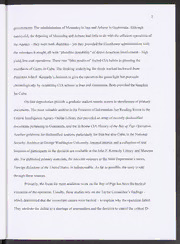
The Central Intelligence Agency and Cuba: How the Trap of Success Led to the Bay of Pigs PDF
Preview The Central Intelligence Agency and Cuba: How the Trap of Success Led to the Bay of Pigs
COLUMBUS STATE UNIVERSITY THE CENTRAL INTELLIGENCE AGENCY AND CUBA: HOW THE TRAP OF SUCCESS LED TO THE BAY OF PIGS A THESIS SUBMITTED TO THE COLLEGE OF LETTERS AND SCIENCE IN PARTIAL FULFILLMENT OF THE REQUIREMENTS FOR THE DEGREE OF MASTER OF ARTS DEPARTMENT OF HISTORY AND GEOGRAPHY BY YANDY OROZCO COLUMBUS, GEORGIA 2017 THE CENTRAL INTELLIGENCE AGENCY AND CUBA: HOW THE TRAP OF SUCCESS LED TO THE BAY OF PIGS By Yandy Orozco Committee Chair: Dr. Dan Crosswell Committee Members: Dr. Doug Tompson Columbus State University December 2017 ABSTRACT This research looks at how covert operations in Iran and Guatemala shaped the decision to launch the Bay of Pigs invasion, and why the United States government embarked on an operation that had little chance of success. Key areas of discussion are the Central Intelligence Agency (CIA) and its role in the removal of Prime Minister Mohammed Mossadeq (Iran) and President Jacobo Arbenz (Guatemala), the Dulles faction, the anti-Castro program, and President Kennedy’s relationship with the CIA. Upon examining these areas, the study shows that the covert action success in Iran and Guatemala fueled American hubris and obviated the recognition of warning signs, which led to the approval of an operation doomed to fail. INDEX WORDS: Central Intelligence Agency, Cuba, Bay of Pigs, John F. Kennedy, Iran, Guatemala, Fidel Castro. IV TO MY BEAUTIFUL WIFE ANGELICA Thank you for your unwavering support. Thank you for putting up with many long weekends where going out and spending time together meant sitting in the couch watching TV while I wrote all day. Thank you for your unconditional love and understanding. I love you. Te amo. V ACKNOWLEDGEMENTS I wish to express my sincere thanks and gratitude to my mentor, Dr. Dan Crosswell, for his stalwart support and mentorship. His insightful observations, motivation, dedication, and brilliant academic mind were invaluable assets. VI TABLE OF CONTENTS DEDICATION.iv ACKNOWLEDGEMENTS .v INTRODUCTION.1 CHAPTER ONE.4 1.1 The Counter-Coup in Iran.5 1.2 Guatemala.13 1.3 The Dulles Faction.21 CHAPTER TWO.26 2.1 Planning PBSUCCESS.26 2.2 The Dulles Faction vs. The Circumspect Spies.32 2.3 Costly Mistakes.35 2.4 Crossing the Border.42 CHAPTER THREE .49 3.1 Dealing with Castro.51 3.2 The Dulles Faction Jumps into Action.54 3.3 Creating the Plan.58 3.4 The Anti-Castro Program.61 CHAPTER FOUR.70 4.1 The Setbacks.70 4.2 From Guerrillas to Invasion Force.75 4.3 Eisenhower’s Hidden-Handed Leadership .78 4.4 A Well-Known Secret.80 vii 4.5 Sloppy Work .83 4.6 Ignoring the Warning Signs.84 CHAPTER FIVE .88 5.1 The Bromance.89 5.2 The First Meeting.93 5.3 Evaluation of the CIA Plan.97 5.4 Feeling the Pressure .99 5.5 The Decision .102 5.6 Inflated Assertions, Misunderstandings, and Naivete.106 CONCLUSION.HI BIBLIOGRAPHY 118 1 Introduction In Cuba, the regime frames the Bay of Pigs as La primera derrota del imperialismo en America Latina (Imperialism’s first defeat in Latin America). I grew up listening and reading how the “Revolution,” under the unwavering leadership of Fidel Castro, defeated the “Yankees” on the shores of Playa Giron (Giron Beach). Within the Cuban exile community in Miami, the narrative is strikingly different. As a Cuban emigre living in Little Havana, I learned that the Cuban exile force failed not because of Castro’s military genius, but because of Kennedy’s betrayal; his decision to cancel the critical D-Day air strikes. Exposed to both sides of the story and being a military officer made me want to reexamine the Bay of Pigs from a strictly military viewpoint. However, I realized that a postmortem of the military action would become mostly speculation and it has already been done; it would have been a case of filtered wine into an old bottle. It might have been justified if this was a Military Masters program at the Command and General Staff College, but not for a MA in history. Instead, the focus of my project centers on answering a simple historical question: Why did the United States embark on an operation knowing it had little chance of success? To answer that question, a researcher must get into the decision-making process; into the mindset of the individuals and agencies who made the decision. Through my research, it became evident that a culture existed within the Central Intelligence Agency (CIA) based on an abiding faith in the efficacy of covert operations. The Cold War mentality informed United States foreign relations; in the 1950s, historians speak of the primacy of foreign over domestic policy. In the struggle of good versus evil - like a John Ford western - the good guys wore white hats and the bad guys wore black. There was no place for shades of gray. This mindset prompted the Eisenhower administration, through CIA-orchestrated covert actions, to overthrow two lawfully elected
